
Image Source: Generated by Wujie AI
I wonder how many people still remember Google Nose.
This quirky project launched by Google on April Fools' Day in 2013 claimed to have a database of 15 million different smells, allowing users to simply enter a keyword in the Google search box, click "smell," and then be able to smell the scent of the object directly next to the computer, such as the smell of a new car, campfire, and even the smell of an ancient Egyptian tomb (?), and so on.
It is this outrageous and imaginative joke from a decade ago that is now being partially turned into reality by some of its inventors.
In early September of this year, the journal "Science" published a paper jointly released by several research teams, including the startup company Osmo (spun off from Google) and the Monell Chemical Senses Center, which stated that AI models can give machines a better "sense of smell" than humans.
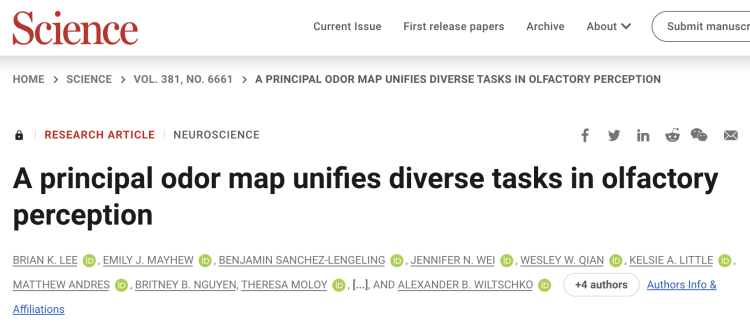
At first glance, this seems incredible, especially since for the general public, the sense of smell is much more abstract than vision and hearing. The RGB color spectrum can describe the colors seen by the human eye, and the sounds heard by the human ear can also be converted into different frequencies of wavelengths, even causing vibrations, but the sense of smell, which cannot be seen or touched, is more difficult to describe with quantifiable metrics.
In other words, digitizing smells sounds like an impossible task.
And what the researchers of this paper are trying to do is to create a high-dimensional map of human olfaction that accurately reflects the characteristics of smells, known as the Principle Odor Map (POM).
So how exactly did they do it?
We know that smell is the human olfactory system's response to certain specific molecules dispersed in the air. When odor molecules enter the nostrils, they react with olfactory cells located above the nasal cavity (receptors), and the resulting bioelectric waves are then transmitted to the brain through nerves, which then identify the smell.
The composition of smells is actually much more complex than colors and sounds, with millions of different types, each smell being composed of hundreds of different chemical molecules, each with different properties. Correspondingly, humans have about 400 functional olfactory receptors, far more than the 4 used for vision and the approximately 40 used for taste.
So faced with such a complex olfactory mechanism, the first thing the researchers did was to create a machine learning model - the message-passing neural network (MPNN).

Model schematic
This is a specific type of graph neural network (GNN), as graph neural networks are a type of deep learning method based on graph structures, which introduces traditional graph analysis and provides a method for extracting features from irregular data, making it very suitable for learning complex olfactory features.
Once the model was built, the next step was to feed it with learning materials.
The researchers combined the Good Scents and Leffingwell & Associates (GS-LF) fragrance and flavor database to establish a reference dataset containing about 5,000 molecules as the training base material. Each molecule can have multiple odor labels, such as fruity, floral, cheesy, and minty, among others.
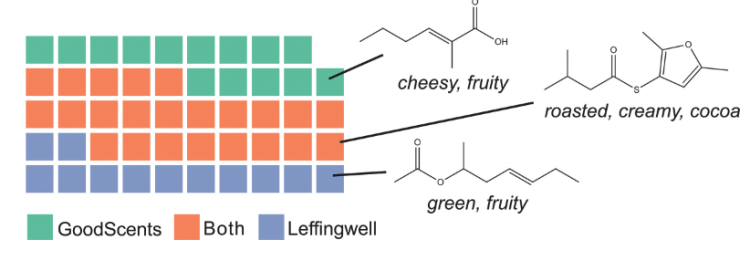
Some molecules in the GS-LF database
By inputting the shape structure of the molecules as data, the model was able to output the corresponding odor words that best describe a certain smell.
To make the training results more accurate, the researchers also used various methods to optimize the model parameters. For example, they divided the GS-LF fragrance and flavor database into training and test sets in an 8:2 ratio, further dividing the training set into five cross-validation subsets; and used Bayesian optimization algorithms to cross-validate the data and optimize the hyperparameters of the GNN model, among other techniques.
The experiment ultimately resulted in the formation of the high-dimensional olfactory map POM (local):
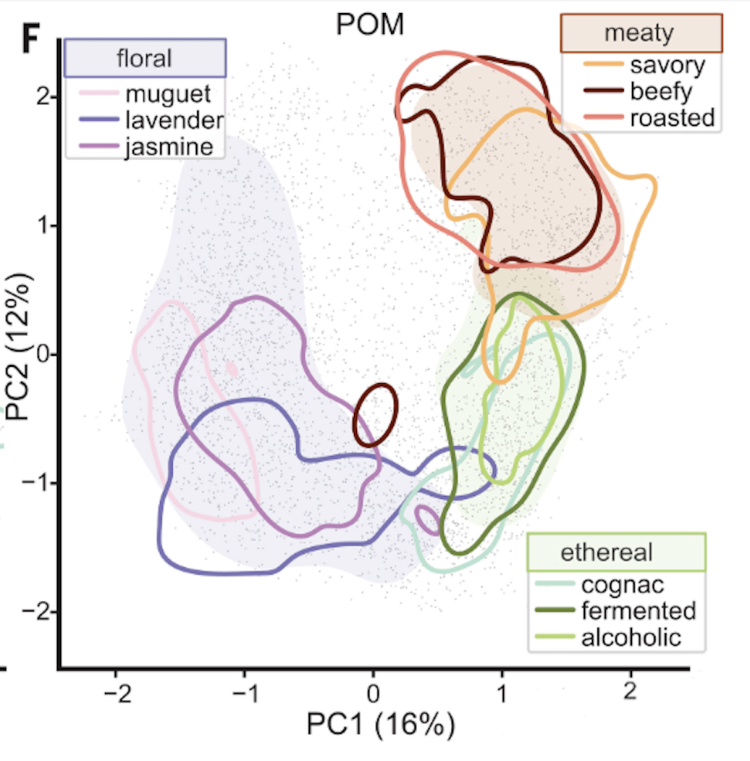
This image intuitively represents the perceptual distance of each smell, for example, there is a significant perceptual distance between major categories such as floral, meaty, and ethereal; but the more specific smells within each major category, such as lily of the valley, lavender, and jasmine under floral, have relatively close perceptual distances.
The paper compared POM with previously researched odor space maps based on Morgan fingerprints and found that the latter could not reflect the aforementioned perceptual distances:
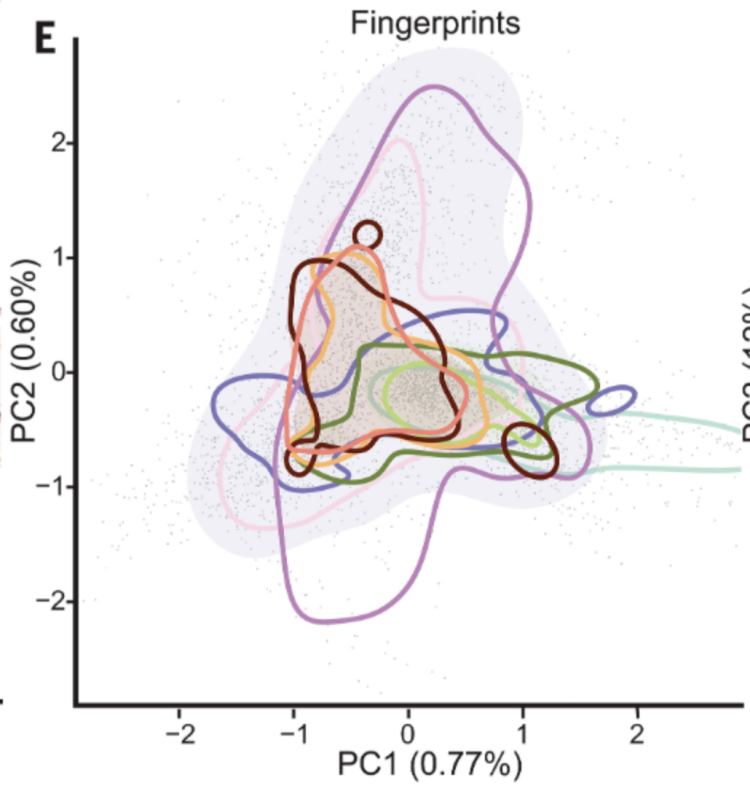
To further validate the model's training effectiveness, the researchers then brought in 15 odor experts to compete with the model to see who could identify smells more accurately.
Each of the 15 experts needed to smell 400 different odors, and the researchers provided 55 odor descriptors for them to rate each odor on a scale of 1-5, assessing to what extent each odor descriptor suited that particular smell.
The results showed that for 53% of the test molecules, the model's performance was better than the group members' average.
The researchers also categorized the model's predicted results by odor descriptors and found that except for musk, the model's predictions of molecular odors were within the error distribution of the human group, and were better than the median of the human group for 30 odor descriptors:
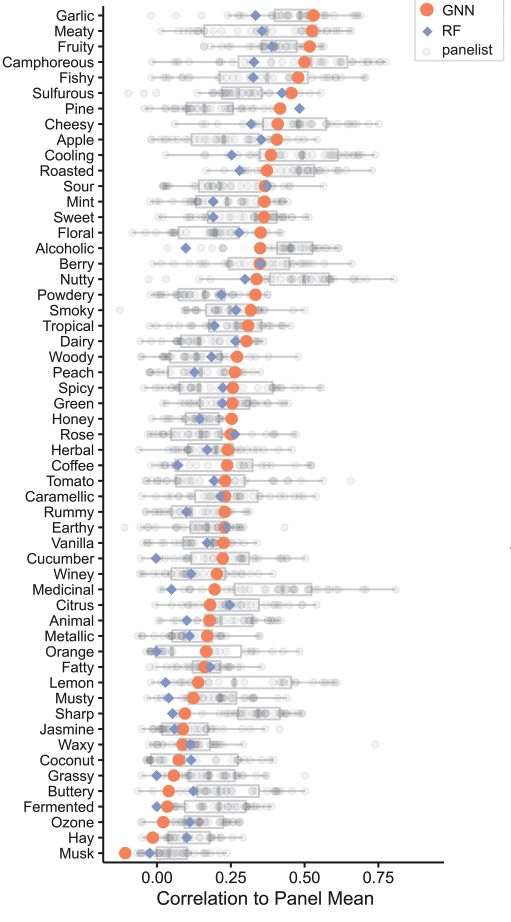
Subsequently, the researchers repeatedly verified the model's performance and obtained a stable relationship between molecular structure and odor.
Next comes the most exciting part, the large-scale drawing of the olfactory map, and the final result is the following image:
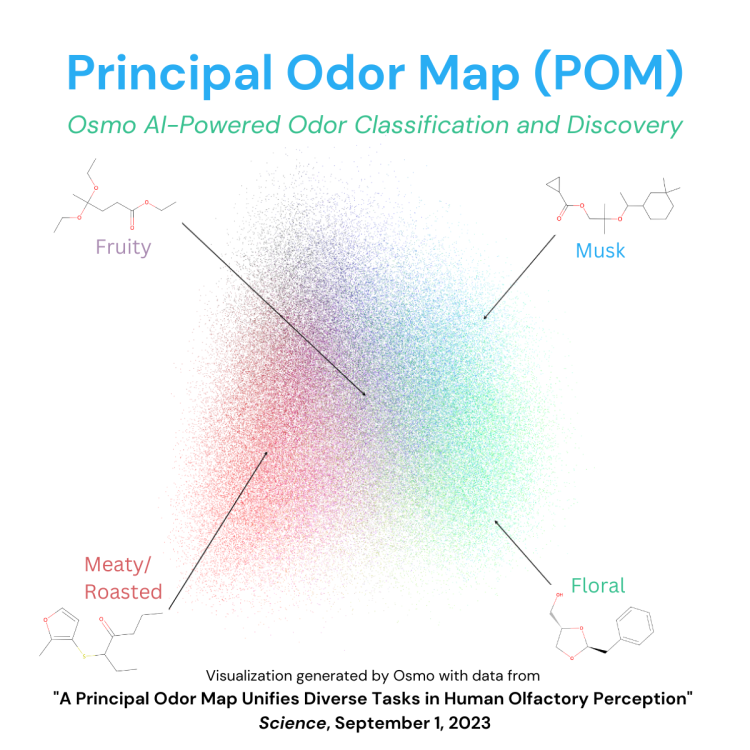
You can understand the coordinate graph representing the perceptual distance of smells mentioned earlier as an infinitely magnified version of this image. The paper mentions that this image contains approximately 500,000 odor molecules, many of which have not even been discovered or synthesized yet (but can indeed be calculated).
To make a more intuitive comparison, if a trained human evaluator were to search for these smells, it would probably take 70 years of continuous work to collect them all.
It seems that this paper has indeed accomplished something significant.
At this point, some netizens asked, why do machines need to smell odors?

Others also gave their own insights, such as suggesting that it could be used for quality control in factory wastewater treatment, for detecting explosives, drugs, or corpses, and so on.
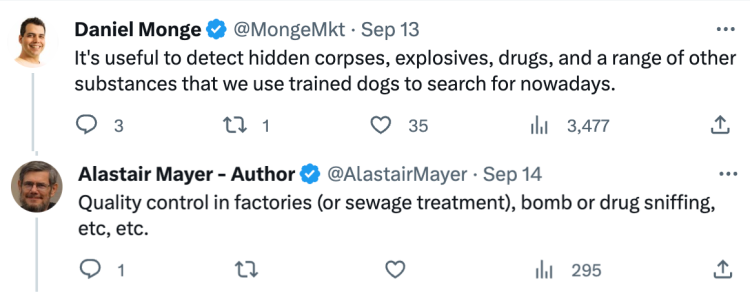
This may mean that police dogs and search and rescue dogs might be out of a job.
Some people hope that this research can lead to the development of a good deodorant, as people emit unpleasant odors after engaging in a lot of aerobic exercise such as running or weightlifting:

Others are very interested in the medical applications of this research, such as using it to develop new therapies for anosmia, or detecting diseases through odor, and so on:

There are also professionals in the perfume industry who feel that this has been a great help, "let it tell my colleagues when they have sprayed too much cologne":

These predictions are actually quite reasonable. First of all, machines can indeed help humans with the problem of sometimes inaccurate odor identification - research has shown that each person's perception of odors varies, triggering different reactions based on sensations and physiological signals, which are also influenced by experience, expectations, personality, or situational factors.
And sometimes, odors are very important to humans.
Not to mention bad odors, some harmful gases may also pose health risks. In such cases, if machines can replace certain specific occupations to help humans or animals, that would be ideal.
For other professions that can benefit from certain odors, such as perfumers, chefs, designers, artists, and architects, there is also a need to create more functional odors. Some situations use odors in the environment, such as the Sloan-Kettering Cancer Center in New York, which disperses vanilla oil in the air to reduce patients' claustrophobia during magnetic resonance imaging (MRI) tests; the Chicago Mercantile Exchange also disperses specific odors to reduce the noise level in the trading floor.
Research has also shown that most of the odor-related memories of humans come from the first ten years of infancy and childhood, while memories produced by language and vision usually occur between the ages of 10 and 30. This partly explains why odors can evoke distant memories for people, and the memories evoked through odors are often more emotionally inclined than those evoked through vision or hearing.
So the connection between odors and humans is very close, it's just that we often don't notice it.
The speculations of netizens were also validated by one of the authors of the paper, Alex Wiltschko from Osmo, in an article published on the official Osmo website. He wrote,
"The odor map is the basis for us to achieve even greater goals. If we can develop a system that can replicate our noses or a dog's nose, we can detect diseases earlier; artificial intelligence will also help doctors find drugs that are more likely to be successful in clinical practice, and better assist synthetic chemists and perfumers in their work… Our future goal is to lay a solid scientific and commercial foundation for improving human health and happiness."
However, he also stated that the paper still has many shortcomings.
For example, it cannot reflect the intensity of molecular odors, it can only predict what they smell like; it only predicted the odor of individual molecules, while in real life, there are more mixed odors; and even if all capabilities are achieved, replicating and restoring odors will still be a major challenge, and so on.
Finally, after all that, one netizen's comment was quite simple, "I think this will take the fun out of wine tasting":

免责声明:本文章仅代表作者个人观点,不代表本平台的立场和观点。本文章仅供信息分享,不构成对任何人的任何投资建议。用户与作者之间的任何争议,与本平台无关。如网页中刊载的文章或图片涉及侵权,请提供相关的权利证明和身份证明发送邮件到support@aicoin.com,本平台相关工作人员将会进行核查。




